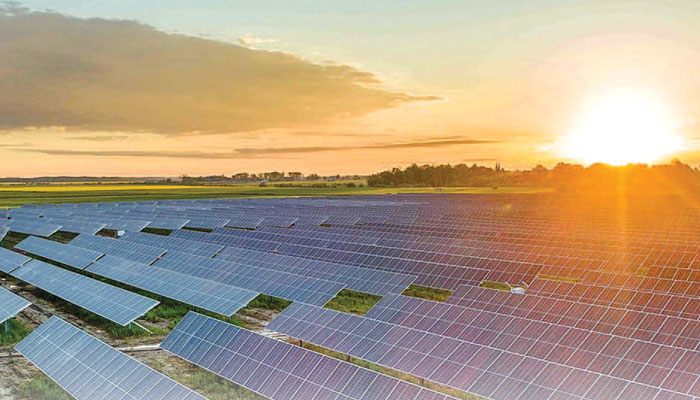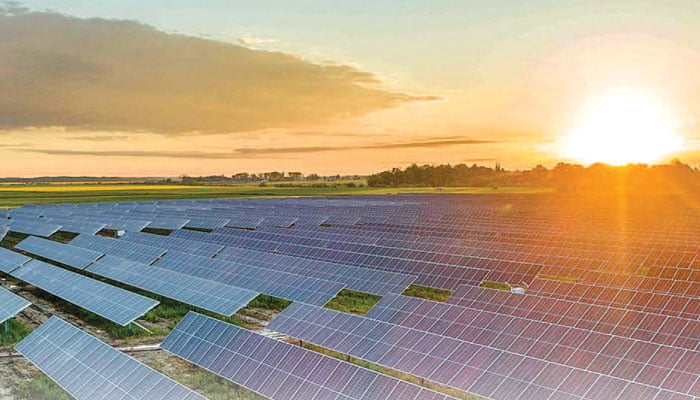
Huzaifa Ahmed
Many people have to face problems due to power crisis. To solve this problem, scientists are creating new things. Last year, researchers in a laboratory in England lit a solar-powered lamp with a tiny solar cell just one centimeter square. The device consisted of cells that were stacked on top of each other. The bottom is made of a type of silicon used in a typical solar panel, but the top is made of perovskite, a crystal structure that specifically converts electricity into light. . The solar cell meanwhile converted 28 percent of the light into electricity, a record performance for a perovskite silicon device.
When the tiny golden cell was put into a small plane at the National Renewable Energy Laboratory (NREL) in Leer-du, the experts discovered it. A silicon solar panel has an efficiency of 23 percent, compared to a theoretical silicon efficiency of about 92 percent. Silicon mainly uses the red and infrared of solar energy. Perovskites, on the other hand, can make more use of the light that reaches them and work in different parts of the spectrum. According to experts, two materials in a cell pair together to convert more photons into electrons. can do
Their special feature is that they can convert even less electrons alone. In 2016, the German factory Bosch Solar used it and it will supply the perovskite and silicon-based solar cells market by the end of 2017. The scientists designed the two materials so that they look like any other typical solar panel, are sealed the same way, and are installed the same way. According to Joey Berry, head of the perovskite research program at the National Renewable Laboratory, there is a whole set of things that would make it a viable technology. But the list of technologies trying to compete with silicon is long.
In the 2000s, efforts were made to introduce more flexible solar energy materials, including thin-film technologies such as cadmium toluride and prandium-calcium silicate. This includes organic solar cells. Given this, experts speculated that such materials would be relatively cheap to produce and could be produced in a variety of sizes. But silicon solar panels were a fast-moving target. 2000 The country’s modular cell and its share of the global market had begun in the mid-2010s. Commercial silicon panel prices halved from 2010 to 2013, and no equivalent was produced.
But the theoretical efficiency of a single layer of perovskite solar panels can reach 33 percent, while the efficiency of a tandem perovskite-silicon device can reach about 43 percent. The advantage of higher efficiency is that you can generate more electricity. Can or can generate more energy with less cost from a smaller footprint. The company’s chief technical officer, Thambs Toombs, says that silicon requires expensive and precise plants and machines. Because perovskite can be flexible, semitransparent, and lightweight, it can be used in places where heavy, rigid solar panels won’t work.
Also NREL. According to Ujol Jain, CEO of NREL-affiliated startup SoftSolar, the company is trying to make perovskite tandem solar cells. Also, it is used in drones and electric vehicles to extend their range. This type of cell works very well with a silicon layer and is more flexible and lightweight.
New solar technologies like perovskite can essentially help eliminate the need for natural fuels, says Veerun Sivaram, chief technology officer at ReNew Power. But a question arises, why do we need silicon to compete with coal plants if we have cheap solar power plants? This is because the problem with solar power plants is that if they are generating enough electricity into the grid, the capacity of subsequent plants to generate additional electricity is reduced. This is because solar farms do not generate electricity at night.
On the other hand, the system can generate much more electricity in hot weather. This is already happening in cities with better solar power production such as Germany, China and California. According to the NREL report, the cheapest commercial system has a total cost of 1.06 per watt. Due to hardware installation and wiring. Sivaram says that perovskite is the best material for solar energy.
setTimeout(function(){
!function(f,b,e,v,n,t,s)
{if(f.fbq)return;n=f.fbq=function(){n.callMethod?
n.callMethod.apply(n,arguments):n.queue.push(arguments)};
if(!f._fbq)f._fbq=n;n.push=n;n.loaded=!0;n.version=’2.0′;
n.queue=[];t=b.createElement(e);t.async=!0;
t.src=v;s=b.getElementsByTagName(e)[0];
s.parentNode.insertBefore(t,s)}(window,document,’script’,
‘https://connect.facebook.net/en_US/fbevents.js’);
fbq(‘init’, ‘836181349842357’);
fbq(‘track’, ‘PageView’);
}, 6000);
/*setTimeout(function(){
(function (d, s, id) {
var js, fjs = d.getElementsByTagName(s)[0];
if (d.getElementById(id)) return;
js = d.createElement(s);
js.id = id;
js.src = “//connect.facebook.net/en_US/sdk.js#xfbml=1&version=v2.11&appId=580305968816694”;
fjs.parentNode.insertBefore(js, fjs);
}(document, ‘script’, ‘facebook-jssdk’));
}, 4000);*/



